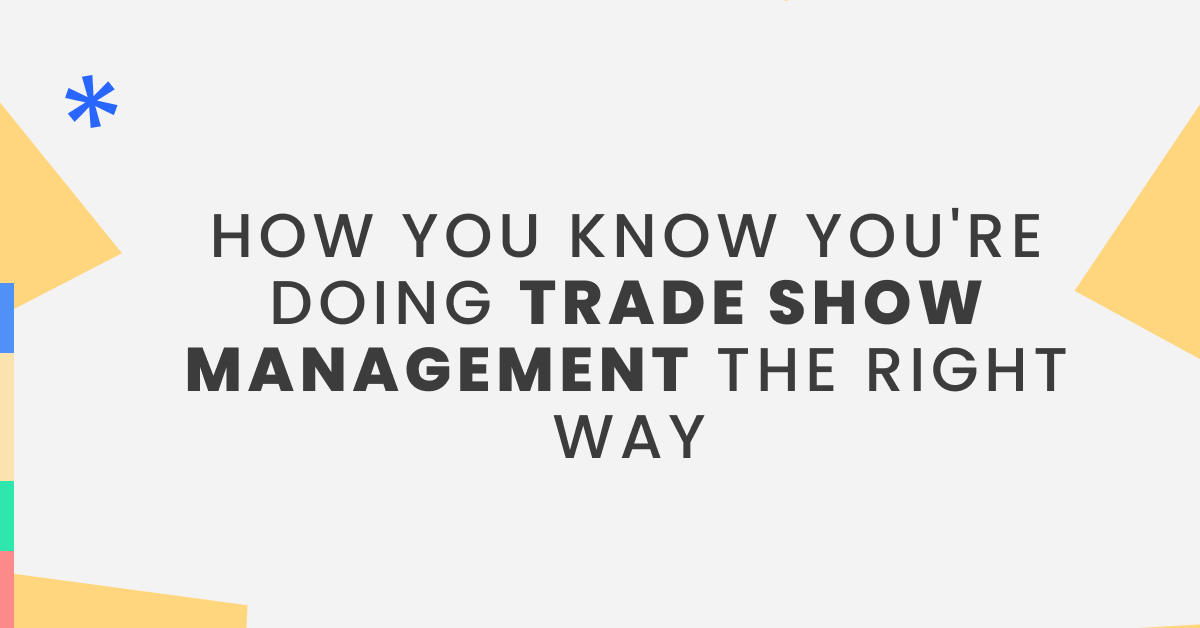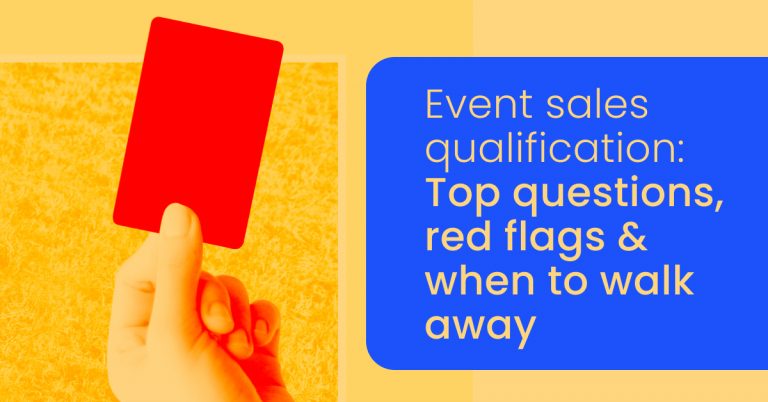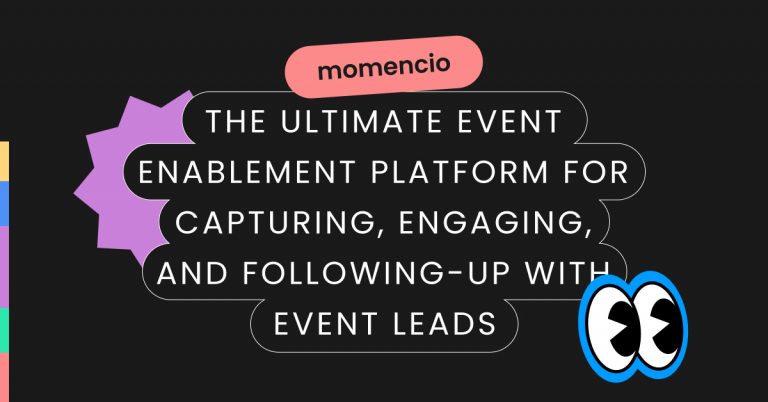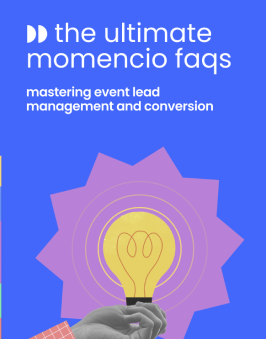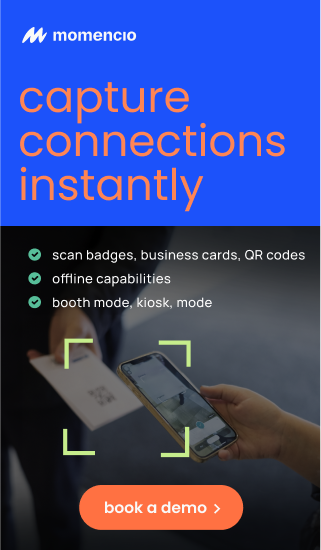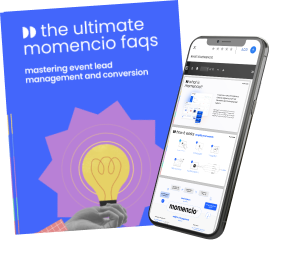Trade shows are essential to get your product in front of distributors and industry leaders. To make the most of trade show marketing, you have to choose the right event and exploit the opportunity in the lead-up and days after. Trade show management is an art that, when done right, can help build your business.
TL;DR: Effective trade show management involves planning, logistics, and engagement strategies to ensure a successful event. From booth design to attendee interactions, this guide helps you streamline operations, capture high-quality leads, and boost your trade show ROI.
What is trade show management?
Trade show management is the process of planning, organizing, and executing all the elements involved in participating in or hosting a trade show. It’s not just about showing up and setting up a booth—it’s a strategic operation aimed at maximizing visibility, engagement, and ROI. From pre-event marketing to on-site logistics and post-event follow-ups, trade show management ensures that every aspect of the event runs smoothly and delivers measurable results.
Effective trade show management starts with clear goals. Whether your aim is to generate leads, increase brand awareness, or showcase new products, every decision—from booth design to staffing—should align with these objectives. It involves meticulous planning, including securing the right space, creating a compelling booth layout, and designing promotional materials that capture attention.
During the event, trade show management focuses on engaging attendees and capturing valuable data. Strategies like using interactive booth elements, deploying advanced lead capture tools, and hosting live product demos can draw in crowds and spark meaningful conversations. Integrating tools like universal lead retrieval systems ensures seamless data collection and minimizes the risk of missing important connections.
Post-event, trade show management shifts to evaluating outcomes and executing targeted follow-ups. Metrics like attendee engagement, lead quality, and conversion rates help measure success. By analyzing these insights, businesses can refine their approach for future events, ensuring continual improvement and greater ROI.
In short, trade show management is the backbone of any successful trade show strategy. When done right, it transforms a hectic event into a well-oiled machine that drives growth, fosters relationships, and achieves business goals.
Trade show management best practices
Understanding your audience
Effective trade show management begins with a deep understanding of your target audience. Knowing their preferences, pain points, and expectations ensures that the trade show resonates with them, making your event a must-visit. This foundational step not only enhances the attendee experience but also increases the likelihood of achieving your business objectives.
Strategic planning and organization
Matic planning and organization are at the heart of successful trade show management. This includes everything from selecting the right venue to designing the booth layout and scheduling engaging activities. Utilizing a comprehensive trade show management strategy ensures that every aspect of the event is aligned with your marketing goals, thereby maximizing event ROI.
Leveraging technology
Modern trade show management heavily relies on technology to streamline processes and enhance attendee engagement. From digital registration systems to lead capture apps and interactive displays, technology can significantly elevate the trade show experience. Implementing these tools effectively requires a strategic approach to trade show management, ensuring that technology serves to complement and enhance the overall event.
Networking and relationship building
Trade show management is not just about the logistics; it’s also about fostering connections. Successful trade show management strategies include dedicated networking opportunities that encourage interactions among attendees, exhibitors, and industry leaders. These connections can lead to fruitful partnerships, lead generation, and other opportunities long after the trade show has concluded.
Measuring success
An often overlooked aspect of trade show management is the post-event analysis. Collecting and analyzing data related to attendee engagement, lead generation, and overall satisfaction allows for a comprehensive understanding of the event’s impact. Effective trade show management involves using these insights to refine future strategies and ensure continuous improvement.
Trade show management the right way
Find the right venue
Many trade shows are a potential fit for your product. It’s essential to invest in the right one. Have a look at the list of attendees so you know your audience. If that information is kept confidential, review publicity information from prior years. That way, you’ll get a sense of the buyers and sellers that made their mark.
Remember that it’s not just an industry fit but a development fit as well. If you are in the early stages of product development, you may want to reach a different trade show audience than if you are an established brand. Know ahead of time what venues are showcasing the next big thing and which ones are looking for the latest incarnation of a trusted company.
Choose a good location
Once you’ve chosen a trade show, you want attendees to see you. Hundreds of exhibitors compete for attention. You want a space big enough to accommodate your experiential marketing and truly show off what you have on offer. You also want to be in a spot that’s accessible for people strolling casually through the trade show.
Hopefully, you’ve already given your potential leads a heads-up that you’ll be at the show, so they will know where to find you wherever you are.
Offer show specials
Everyone likes a deal—and at a trade show, it’s no different. Making early sales is crucial to creating a buzz around your product.
Harness the excitement of a trade show and let potential buyers know they will save big if they get in early. Best of all, you can offer your early adopters ongoing updates of where your product is going and how the company is developing in the weeks and months after the show.
Run contests and promotions
Freebies are a way to “expand your reach” beyond your booth. If you’ve ever been to a trade show, you’ll know that swag is part of the deal. This makes attendees happy — everyone likes free stuff — but also gives them the chance to carry your brand with them around the floor.
Contests and promotions also give attendees another opportunity to engage with your product at a lower cost. By signing people up for a contest, you’ll have a ready-made mailing list for after the show.
Use event management software
The trade show is a multi-phase event. You begin by choosing the show; then, you let your existing customers and distributors know you’ll be attending. During the event, you do your best to create some buzz. Afterward, you follow up with the people you met there. All of these phases require a great deal of organization. If you’re doing things right, you should have in-depth analytics that let you know which one of your contacts came to the trade show and how many new contacts converted later. Trade show management software is an important investment that helps you make the most of your trade show attendance.
Engage in Post-show follow-up
Everyone you meet at a trade show also meets dozens, if not hundreds, of other entrepreneurs. You should see the trade show as the beginning of these relationships. Follow up with people you engaged with by sending them automated emails in the days and weeks after the show. Encourage them to spread the word about what you do and how it can improve their lives.
Industry events are an investment, but they can transform your business with on-target trade show management. Make the most of every contact you make.
Check out our Ashland case study – Interactive experiences
Maximizing in-booth engagement
Engagement-driven booth design: Create an inviting and interactive booth design that naturally draws attendees. Utilize dynamic displays, interactive demos, and comfortable seating areas to encourage longer visits. Incorporating elements of your brand story can make the experience memorable and shareable.
Interactive product demonstrations: Interactive demos not only showcase your product’s features but also engage attendees on a personal level. Tailor these demonstrations to highlight how your product solves specific problems or enhances efficiency.
Training your team for engagement: Your booth staff should be well-versed in both product knowledge and engagement techniques. Training sessions before the event can prepare your team to effectively interact with attendees, capture leads, and convey your product’s value proposition.
Real-time feedback collection: Use digital surveys or interactive polls to collect feedback during the trade show. This will not only engage attendees but also provide valuable insights into their preferences and perceptions.
Leveraging technology for trade show success
Advanced lead capture tools: Implement lead capture technologies such as QR/Badge scanners, NFC tags, or RFID systems to streamline the collection of attendee information. Tools like momencio offer sophisticated lead capture solutions that integrate seamlessly with your CRM.
Event management software for efficiency: Utilize comprehensive event management platforms to organize schedules, track leads, and analyze engagement metrics. Software like momencio provides a centralized dashboard for real-time insights and follow-up automation.
Enhancing engagement with augmented reality (AR): Incorporate AR experiences to stand out and create an immersive booth experience. AR can be used to demonstrate complex product features, provide virtual tours, or gamify the learning process.
Social media integration: Integrate your trade show activities with social media platforms. Use live feeds, hashtags, and interactive content to expand your reach beyond the trade show floor. Engaging attendees online can extend the lifecycle of each interaction.
Implementing effective follow-up strategies
Segmenting leads for personalized follow-up: Categorize leads based on their interest level, product preference, or interaction type. This segmentation allows for more targeted and relevant follow-up communications.
Utilizing automation for efficiency: Deploy automated email sequences tailored to each lead segment. Platforms like momencio can automate this process, ensuring timely and personalized follow-ups that move leads further down the sales funnel.
Measuring success and ROI: Post-event analysis is crucial for measuring the effectiveness of your trade show strategy. Analyze lead conversion rates, engagement metrics, and overall ROI to refine future trade show participation.
Success at trade shows hinges on engaging booth designs, effective use of technology, and strategic follow-ups. By leveraging advanced event marketing tools like momencio, businesses can enhance in-booth engagement, streamline lead management, and significantly improve their trade show ROI.
The future of trade show management
Hybrid event integration
The future of trade show management is set to be dominated by hybrid events that combine the best aspects of physical and virtual formats. This approach not only broadens the reach of the event but also caters to a wider audience with varying preferences. Embracing this trend requires trade show managers to be adept at seamlessly managing both in-person and digital experiences.
Sustainability practices
Eco-consciousness is becoming increasingly important in trade show management. Future events will likely emphasize sustainable practices, from digital brochures and reusable materials to energy-efficient booth designs. Incorporating these elements into trade show management practices not only reflects positively on the brands involved but also aligns with the growing demand for environmental responsibility.
Advanced-data analytics
As trade show management evolves, so does the role of data analytics in shaping event strategies. The use of sophisticated data analysis tools to track attendee behavior, engagement levels, and overall event performance will become standard in trade show management. This will enable organizers to create highly personalized and engaging experiences, driving the success of future trade shows.
AI and machine learning
The incorporation of AI and machine learning into trade show management is poised to revolutionize the way events are planned, executed, and analyzed. From personalized recommendations for attendees to predictive analytics for exhibitors, AI can significantly enhance the efficiency and effectiveness of trade show management.
Continuous engagement
Future trade show management strategies will likely focus on creating year-round engagement with audiences. Instead of viewing trade shows as standalone events, successful trade show management will involve maintaining an ongoing dialogue with participants through digital content, webinars, and community-building activities. This approach ensures that the momentum generated by the trade show continues to drive business goals forward.
By adhering to these best practices and staying attuned to future trends, professionals involved in trade show management can ensure their events remain relevant, engaging, and successful in achieving their strategic objectives.
Conclusion
Success at trade shows hinges on engaging booth designs, effective use of technology, and strategic follow-ups. By leveraging advanced event marketing tools like momencio, businesses can enhance in-booth engagement, streamline lead management, and significantly improve their trade show ROI.
Elevate your trade show strategy with cutting-edge technology and personalized engagement. Learn more about how momencio can transform your trade show results. Book your demo today and take the first step towards unparalleled trade show success.
FAQs on Trade Show Management
- How do I choose the right trade show for my product?
- Selecting the ideal trade show involves researching the event’s audience, history, and the types of exhibitors and attendees it attracts. Consider shows where the attendee profile matches your target market. Reviewing past years’ exhibitor lists and attendee feedback can provide insight into the show’s relevance to your business.
- What strategies can I employ to ensure my booth stands out?
- To make your booth stand out, focus on strategic placement that maximizes foot traffic, invest in eye-catching designs, and incorporate interactive elements or technology to engage attendees. Pre-show marketing to alert potential leads of your presence is also crucial.
- How effective are show specials in attracting potential buyers?
- Show specials are highly effective in creating a buzz around your booth. Offering limited-time discounts or exclusive deals can draw attendees to your exhibit and facilitate early sales, setting the tone for future engagement.
- Can you suggest some engaging contests or promotions for trade shows?
- Engaging contests and promotions might include social media challenges that encourage booth visits, product-related quizzes with prizes, or a raffle for a high-value item. These activities not only attract attendees but also provide opportunities to collect lead information.
- Why is event management software critical for trade show success?
- Event management software streamlines the organization and follow-up process, enabling you to schedule meetings, track lead engagement, and analyze the effectiveness of your trade show participation. Software like momencio offers comprehensive solutions for managing leads before, during, and after the event, enhancing the overall ROI.
- How should I approach post-show follow-up?
- Post-show follow-up should be timely and personalized. Use the lead information gathered during the show to send targeted emails, newsletters, or offers. Utilizing a platform like momencio can automate and personalize these follow-ups, ensuring no lead is overlooked.
- What are the keys to maximizing trade show ROI?
- Maximizing trade show ROI involves effective pre-show marketing, engaging booth design, strategic lead capture, and diligent post-show follow-up. Incorporating an all-encompassing event marketing tool like momencio can significantly enhance your trade show success by providing real-time insights and automating lead management processes.
Trade shows offer a unique opportunity to connect directly with your industry, market, and potential clients. With the right strategy, including the selection of the right event, an engaging booth setup, effective promotions, and the use of advanced event management tools like momencio, businesses can significantly improve their trade show outcomes.
